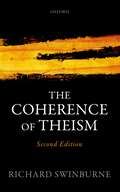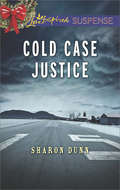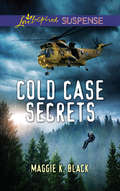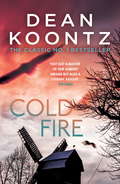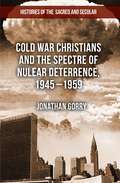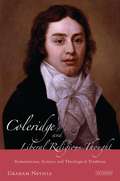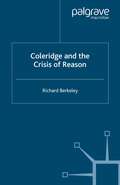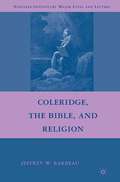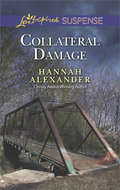- Table View
- List View
Cognitivity of Religion: Three Perspectives (pdf) (Library of Philosophy and Religion)
by J. KellenbergerThe Coherence of Theism (Clarendon Library of Logic and Philosophy)
by Richard SwinburneThe Coherence of Theism investigates what it means, and whether it is coherent, to say that there is a God. Richard Swinburne concludes that despite philosophical objections, most traditional claims about God are coherent (that is, do not involve contradictions); and although some of the most important claims are coherent only if the words by which they are expressed are being used in analogical senses, this is the way in which theologians have usually claimed that they are being used. When the first edition of this book was published in 1977, it was the first book in the new 'analytic' tradition of philosophy of religion to discuss these issues. Since that time there have been very many books and discussions devoted to them, and this new, substantially rewritten, second edition takes account of these discussions and of new developments in philosophy generally over the past 40 years. These discussions have concerned how to analyse the claim that God is 'omnipotent', whether God can foreknow human free actions, whether God is everlasting or timeless, and what it is for God to be a 'necessary being'. On all these issues this new edition has new things to say.
The Coherence of Theism: Second Edition (Clarendon Library of Logic and Philosophy)
by Richard SwinburneThe Coherence of Theism investigates what it means, and whether it is coherent, to say that there is a God. Richard Swinburne concludes that despite philosophical objections, most traditional claims about God are coherent (that is, do not involve contradictions); and although some of the most important claims are coherent only if the words by which they are expressed are being used in analogical senses, this is the way in which theologians have usually claimed that they are being used. When the first edition of this book was published in 1977, it was the first book in the new 'analytic' tradition of philosophy of religion to discuss these issues. Since that time there have been very many books and discussions devoted to them, and this new, substantially rewritten, second edition takes account of these discussions and of new developments in philosophy generally over the past 40 years. These discussions have concerned how to analyse the claim that God is 'omnipotent', whether God can foreknow human free actions, whether God is everlasting or timeless, and what it is for God to be a 'necessary being'. On all these issues this new edition has new things to say.
Coins as Cultural Texts in the World of the New Testament
by David H. WenkelCoins have long been a vital part of the discipline of classical studies of the ancient world. However, many scholars have commented that coins have not been adequately integrated into the study of the New Testament. This book provides an interdisciplinary gateway to the study of numismatics for those who are engaged in biblical studies. Wenkel argues that coins from the 1st century were cultural texts with communicative power. He establishes a simple yet comprehensive hermeneutic that defines coins as cultural texts and explains how they might be interpreted today. Once coins are understood to be cultural texts, Wenkel proceeds to explain how these texts can be approached from three angles. First, the world in front of the coin is defined as the audience who initially read and responded to coins as cultural texts. The entire Roman Empire used coins for payment. Second, the world of the coin refers to the coin itself – the combination of inscriptions and images. This combination of inscription and image was used ubiquitously as a tool of propaganda. Third, the world behind the coin refers to the world of power and production behind the coins. This third angle explores the concept of authorship of coins as cultural texts.
Coins as Cultural Texts in the World of the New Testament
by Dr David H. WenkelCoins have long been a vital part of the discipline of classical studies of the ancient world. However, many scholars have commented that coins have not been adequately integrated into the study of the New Testament. This book provides an interdisciplinary gateway to the study of numismatics for those who are engaged in biblical studies. Wenkel argues that coins from the 1st century were cultural texts with communicative power. He establishes a simple yet comprehensive hermeneutic that defines coins as cultural texts and explains how they might be interpreted today. Once coins are understood to be cultural texts, Wenkel proceeds to explain how these texts can be approached from three angles. First, the world in front of the coin is defined as the audience who initially read and responded to coins as cultural texts. The entire Roman Empire used coins for payment. Second, the world of the coin refers to the coin itself – the combination of inscriptions and images. This combination of inscription and image was used ubiquitously as a tool of propaganda. Third, the world behind the coin refers to the world of power and production behind the coins. This third angle explores the concept of authorship of coins as cultural texts.
Cold Case Christmas: Military K-9 Unit Christmas Lone Star Christmas Witness Cold Case Christmas (Mills And Boon Love Inspired Suspense Ser.)
by Jessica R. PatchSecrets lie buried in ice… One of them can kill her.
Cold Case Cover-Up: Texas Baby Pursuit Protected Secrets Cold Case Cover-up (Covert Operatives #1)
by Virginia VaughanShe’ll risk everything to uncover her past The first thrilling Covert Operatives tale
Cold Case Murder (Without a Trace #3)
by Shirlee McCoyHer hometown of Loomis, Louisiana, holds no charm for Jodie Gilmore. Why be reminded of her mother's abandonment? Then the novice FBI agent is assigned to a missing person's case, and refusal isn't an option. Her coworkers are counting on her. Surely the tight-lipped locals will talk to one of their own. Or will they?
Cold Case Secrets (True North Heroes #4)
by Maggie K. BlackThe Canadian wilderness can be deadlyA gripping True North Heroes romance
Cold Case Witness (Mills & Boon Love Inspired Suspense): Seek And Find Deception Cold Case Witness
by Sarah VarlandA DANGEROUS HOMECOMING
Cold Fire: An unmissable thriller of suspense and the occult
by Dean KoontzA man with a rare gift. A cynical journalist. A dangerous enemy. Breath-taking and unique, Cold Fire is bestselling author Dean Koontz at his mesmerising best. Perfect for fans of Stephen King and Richard Laymon.'Solid, satisfying, hair-raising Koontz barely lets the reader come up for air between terrors' - The Washington Post 'There is an Enemy. It is coming. It is relentless.'Schoolteacher Jim Ironheart flies on an impulse to Portland, Oregon. There he risks his life to save a child from being killed. Reporter Holly Thorne witnesses his heroism, and is impressed by his self-effacement when he declines to be interviewed.Burnt out, cynical, and looking for a life beyond journalism, Holly finds her newshound's instincts rekindled when she discovers Jim has quietly performed twelve last-minute rescues in twelve far-flung places over the past four months. Realising she is on to the biggest story of her life, Holly traces Jim to California. He insists he is not a psychic; he simply believes God is working through him. Holly thinks his explanation is too easy, that there is no wonder in life, no great mystery.She is dead wrong. For she and Jim are soon plunged into a dark sea of wonder, mystery - and stark terror. And, on the run for their lives, they will be forced to confront a savage and uncannily powerful adversary... What readers are saying about Cold Fire: 'From the first line I was swept away in the story. Twisting and turning to an unexpected ending!''Gripping, thrilling reading''Don't read with the light off!'
Cold War Christians and the Spectre of Nuclear Deterrence, 1945-1959 (Histories of the Sacred and Secular, 1700–2000)
by J. GorryOffering a new interpretation of early Cold War history, this book demonstrates how Christian agency played a pivotal role in the creating of space for the logic of nuclear deterrence and nuclear war, showing a balanced examination of Christians as enablers but, more provocatively, as resisters of nuclear prohibitions.
Cold War Monks: Buddhism and America's Secret Strategy in Southeast Asia
by Eugene FordThe groundbreaking account of U.S. clandestine efforts to use Southeast Asian Buddhism to advance Washington’s anticommunist goals during the Cold War How did the U.S. government make use of a “Buddhist policy” in Southeast Asia during the Cold War despite the American principle that the state should not meddle with religion? To answer this question, Eugene Ford delved deep into an unprecedented range of U.S. and Thai sources and conducted numerous oral history interviews with key informants. Ford uncovers a riveting story filled with U.S. national security officials, diplomats, and scholars seeking to understand and build relationships within the Buddhist monasteries of Southeast Asia. This fascinating narrative provides a new look at how the Buddhist leaderships of Thailand and its neighbors became enmeshed in Cold War politics and in the U.S. government’s clandestine efforts to use a predominant religion of Southeast Asia as an instrument of national stability to counter communist revolution.
Coleridge and Liberal Religious Thought: Romanticism, Science and Theological Tradition (International Library of Historical Studies)
by Graham NevilleFew figures who were active in the English Romantic Movement are as fascinating as Samuel Taylor Coleridge (1772-1834). Aside from his own visionary verse, Coleridge is famous for his colourful friendships with fellow-poets Wordsworth and Southey, and above all for his well documented drug-taking and creative use of opium. But it is altogether less widely appreciated that he was also a key figure in Anglican thought, whose writings are continually referred to by modern Anglican theologians. Coleridge's journey from the Unitarianism of his father towards a later commitment to Anglican Trinitarianism of a type he had rejected in his youth involved a rigorous philosophical process of imaginative liberal thinking. Over the last 200 years, that thinking has provided Anglicanism with many valedictory tools as well as a measure of robust self-belief. Offering a major contribution both to religious history and the history of ideas, Graham Neville here charts the particular liberal tradition in British religious thought which stems directly from Coleridge. Beginning with an account of Coleridge's own spiritual pilgrimage, and the roots of his subject's theology in 17th century writers like John Donne and the Cambridge Platonists, Dr Neville explores Coleridge's quest for a version of Christian orthodoxy which satisfied his Romantic convictions about revelation and his personal need for redemption. Neville explains why Coleridge's thought remains so significant, and traces the ways in which the latter's theological ideas profoundly influenced later British writers and scholars like F. D. Maurice, F. J. A. Hort, F. W. Robertson, B. F. Westcott, John Oman and Thomas Erskine (once called the 'Scottish Coleridge'). The author shows that Coleridge's thinking was influential as far away as New England, especially amongst those who sought to move beyond Calvinist rigidities. Dr Neville further relates the humane ideas of Coleridge to topical modern developments in theology, and shows how Coleridge has inspired subsequent thinkers to pioneer new scientific methods and democratic ideals.
Coleridge and the Crisis of Reason
by R. BerkeleyThis exciting new study examines Coleridge's understanding of the Pantheism Controversy - the crisis of reason in German philosophy - revealing the context informing Coleridge's understanding of German thinkers. It establishes the central importance of the contested status of reason for Coleridge's poetry and later religious thought.
Coleridge, the Bible, and Religion (Nineteenth-Century Major Lives and Letters)
by Jeffrey W. BarbeauBarbeau reconstructs the system of religion that Coleridge develops in Confessions of an Inquiring Spirit (1840). Coleridge's late system links four sources of divinity the Bible, the traditions of the church, the interior work of the Spirit, and the inspired preacher to Christ, the Word. In thousands of marginalia and private notebook entries, Coleridge challenges traditional views of the formation and inspiration of the Bible, clarifies the role of the church in biblical interpretation, and elucidates the relationship between the objective and subjective sources of revelation. In late writings that develop a robust system of religion, Coleridge conveys his commitment to biblical wisdom.
Colin Gunton’s Trinitarian Theology of Culture: Towards a Living Sacrifice of Praise (T&T Clark Studies in English Theology)
by Dr Andrew PicardWhilst upholding some of the criticisms of Colin Gunton's work, this incisive book argues that there is a Hauptbriefe in Gunton reception that assumes his early classic works, The One, the Three and the Many and The Promise of Trinitarian Theology (1st ed), are definitive of his project and fail to engage adequately with the progressions in Gunton's later thought. Instead, this book offers a fresh reading of Gunton by giving greater prominence to his later writings, which are centred in the mediation of the Son and the Spirit in creation.Andrew Picard argues that Gunton's trinitarian theology of culture emerges from his later trinitarian theology of mediation, creation, Christology, pneumatology, and ecclesiology. Exploring these doctrinal foci enables an understanding of Gunton's account of faithful human culture as embodied worship; a living sacrifice of praise which contributes to the divine redemption and perfection of creation. It is the church's particular calling to embody such praise through its visible life in community. The study concludes by intersecting Gunton's theology with the social sciences to critique ableism and consider the politics of the church's belonging in community.
Colin Gunton’s Trinitarian Theology of Culture: Towards a Living Sacrifice of Praise (T&T Clark Studies in English Theology)
by Dr Andrew PicardWhilst upholding some of the criticisms of Colin Gunton's work, this incisive book argues that there is a Hauptbriefe in Gunton reception that assumes his early classic works, The One, the Three and the Many and The Promise of Trinitarian Theology (1st ed), are definitive of his project and fail to engage adequately with the progressions in Gunton's later thought. Instead, this book offers a fresh reading of Gunton by giving greater prominence to his later writings, which are centred in the mediation of the Son and the Spirit in creation.Andrew Picard argues that Gunton's trinitarian theology of culture emerges from his later trinitarian theology of mediation, creation, Christology, pneumatology, and ecclesiology. Exploring these doctrinal foci enables an understanding of Gunton's account of faithful human culture as embodied worship; a living sacrifice of praise which contributes to the divine redemption and perfection of creation. It is the church's particular calling to embody such praise through its visible life in community. The study concludes by intersecting Gunton's theology with the social sciences to critique ableism and consider the politics of the church's belonging in community.
Collateral Damage: Undercover Marriage Collateral Damage Forgotten Past (Mills And Boon Love Inspired Suspense Ser.)
by Hannah AlexanderHOMETOWN SECRETS
Collected Essays: Volume III (The Littman Library of Jewish Civilization)
by Haym SoloveitchikContinuing his contribution to medieval Jewish intellectual history, Haym Soloveitchik focuses here on the radical pietist movement of Ḥasidei Ashkenaz and its main literary work, Sefer Ḥasidim, and on the writings and personality of the Provençal commentator Ravad of Posquières. In both areas Soloveitchik challenges mainstream views to provide a new understanding of medieval Jewish thought. Some of the essays are revised and updated versions of work previously published and some are entirely new, but in all of them Soloveitchik challenges reigning views to provide a new understanding of medieval Jewish thought.The section on Sefer Ḥasidim brings together over half a century of Soloveitchik’s writings on German Pietism, many of which originally appeared in obscure publications, and adds two new essays. The first of these is a methodological study of how to read this challenging work and an exposition of what constitutes a valid historical inference, while the second reviews the validity of the sociological and anthropological inferences presented in contemporary historiography. In discussing Ravad’s oeuvre, Soloveitchik questions the widespread notion that Ravad’s chief accomplishment was his commentary on Maimonides’ Mishneh torah; his Talmud commentary, he claims, was of far greater importance and was his true masterpiece. He also adds a new study that focuses on the acrimony between Ravad, as the low-born genius of Posquières, and R. Zerahyah ha-Levi of Lunel, who belonged to the Jewish aristocracy of Languedoc, and considers the implications of that relationship.
Collected Essays: Volume I (The Littman Library of Jewish Civilization)
by Haym SoloveitchikWritten at different times and for different audiences - some for scholars of rabbinic literature, some for laymen or for scholars not necessarily Jewish - the essays gathered together in this volume nevertheless have an inner coherence. They reflect the author's lifetime interest in the history of halakhah - not as intellectual history per se, but rather a concern to identify measurable deflection in the unfolding of halakhic ideas that could point to an undetected force at work. What was it that stimulated change, and why? What happened when strong forces impinged upon halakhic observance, and both the scholarly elite and the community as a whole had to grapple with upholding observance while adapting to a new set of circumstances? Haym Soloveitchik's elegant presentation shows skilfully that the line between adaptation and deviance is a fine one, and that where a society draws that line is revelatory of both its values and its self-perception. Many of the articles presented here are well known in the field but have been updated for this publication (the major essay on pawnbroking has been expanded to half again its original size); some have been previously published only in Hebrew, and two are completely new. An Introduction highlights the key themes of the collection and explains the underlying methodology. Having these essays in a single volume will enable scholars and students to consult all the material on each theme together, while also tracing the development of ideas. The opening section of the volume is a brief description and characterization of the dramatis personae who figure in all these essays: Rashi and the Tosafists. It covers the halakhic commentaries and their authors; the creativity of Ashkenaz; and the halakhic isolation of the Ashkenazic community. The second section focuses on usury and money-lending, including the practice of pawn-broking, while the third section deals with the ban on Gentile wine and how that connected to the development of money-lending. The final section presents general conclusions in the form of four studies of the communal self-image of Ashkenaz and its attitude to deviation and change.
Collected Essays: Volume III (The Littman Library of Jewish Civilization)
by Haym SoloveitchikContinuing his contribution to medieval Jewish intellectual history, Haym Soloveitchik focuses here on the radical pietist movement of Ḥasidei Ashkenaz and its main literary work, Sefer Ḥasidim, and on the writings and personality of the Provençal commentator Ravad of Posquières. In both areas Soloveitchik challenges mainstream views to provide a new understanding of medieval Jewish thought. Some of the essays are revised and updated versions of work previously published and some are entirely new, but in all of them Soloveitchik challenges reigning views to provide a new understanding of medieval Jewish thought.The section on Sefer Ḥasidim brings together over half a century of Soloveitchik’s writings on German Pietism, many of which originally appeared in obscure publications, and adds two new essays. The first of these is a methodological study of how to read this challenging work and an exposition of what constitutes a valid historical inference, while the second reviews the validity of the sociological and anthropological inferences presented in contemporary historiography. In discussing Ravad’s oeuvre, Soloveitchik questions the widespread notion that Ravad’s chief accomplishment was his commentary on Maimonides’ Mishneh torah; his Talmud commentary, he claims, was of far greater importance and was his true masterpiece. He also adds a new study that focuses on the acrimony between Ravad, as the low-born genius of Posquières, and R. Zerahyah ha-Levi of Lunel, who belonged to the Jewish aristocracy of Languedoc, and considers the implications of that relationship.
Collected Essays: Volume II (The Littman Library of Jewish Civilization)
by Haym SoloveitchikIn this second volume of his essays on the history of halakhah, Haym Soloveitchik grapples with much-disputed topics in medieval Jewish history and takes issue with a number of reigning views. His insistence that proper understanding requires substantive, in-depth analysis of the sources leads him to a searching analysis of oft-cited halakhic texts of Ashkenaz, frequently with conclusions that differ from the current consensus. Medieval Jewish historians cannot, he argues, avoid engaging in detailed textual criticism, and texts must always be interpreted in the context of the legal culture of their time. Historians who shirk these tasks risk reinforcing a version that supports their own preconceptions, and retrojecting later notions on to an earlier age. These basic methodological points underlie every topic discussed. In Part I, devoted to the cultural origins of Ashkenaz and its lasting impact, Professor Soloveitchik questions the scholarly consensus that the roots of Ashkenaz lie deep in Palestinian soil. He challenges the widespread notion that it was immemorial custom (minhag kadmon) that primarily governed Early Ashkenaz, the culture that emerged in the Rhineland in the late tenth century and which was ended by the ravages of the First Crusade (1096). He similarly rejects the theory that it was only towards the middle of the eleventh century that the Babylonian Talmud came to be regarded as fully authoritative. On the basis of an in-depth analysis of the literature of the time, he shows that the scholars of Early Ashkenaz displayed an astonishing command of the complex corpus of the Babylonian Talmud and viewed it at all times as the touchstone of the permissible and the forbidden. The section concludes with his own radical proposal as to the source of Ashkenazi culture and the stamp it left upon the Jews of northern Europe for close to a millennium. The second part of the volume treats the issue of martyrdom as perceived and practised by Jews under Islam and Christianity. In one of the longer essays, Soloveitchik claims that Maimonides’ problematic Iggeret ha-Shemad is a work of rhetoric, not halakhah—a conclusion that has generated much criticism from other scholars, to whom he replies one by one. This is followed by a comprehensive study of kiddush ha-shem in Ashkenaz, which draws him into an analysis of whether aggadic sources were used by the Tosafists in halakhic arguments, as some historians claim; whether there was any halakhic validation of the widespread phenomenon of voluntary martyrdom; and, indeed, whether halakhic considerations played any part in such tragic life-and-death issues. The book concludes with two essays on Mishneh torah which argue that that famed code must also be viewed as a work of art which sustains, as masterpieces do, multiple conflicting interpretations.
Collected Leonard J Arrington Mormon History Lectures (Arrington Lecture Series #10)
by Usu Special SpecialThe first ten lectures in Leonard J. Arrington Mormon History Lecture Series are here collected in one volume. The series, established by one of the twentieth-century West's most distinguished historians, Leonard Arrington, has become a leading forum for prominent historians to address topics related to Mormon history. The first lecturer was Arrington himself. He was followed by Richard Lyman Bushman, Richard E. Bennett, Howard R. Lamar, Claudia L. Bushman, Kenneth W. Godfrey, Jan Shipps, Donald Worster, Laurel Thatcher Ulrich, and F. Ross Peterson. Utah State University hosts the Leonard J. Arrington Mormon History Lecture Series. The University Libraries' Special Collections and Archives houses the Arrington collection. The state's land grant university began collecting records very early, and in the 1960s became a major depository for Utah and Mormon records. Leonard and his wife Grace joined the USU faculty and family in 1946, and the Arringtons and their colleagues worked to collect original diaries, journals, letters, and photographs.

